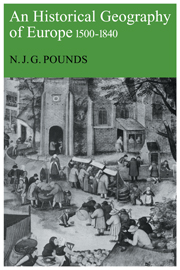Book contents
- Frontmatter
- Contents
- List of maps and diagrams
- List of abbreviations
- Preface
- 1 Europe in the early sixteenth century
- 2 The population of Europe from the sixteenth to the early nineteenth centuries
- 3 The pattern of cities
- 4 Agriculture from the sixteenth to the nineteenth centuries
- 5 Manufacturing and mining
- 6 The pattern of trade
- 7 Europe on the eve of the Industrial Revolution
- Notes
- Index
5 - Manufacturing and mining
Published online by Cambridge University Press: 04 August 2010
- Frontmatter
- Contents
- List of maps and diagrams
- List of abbreviations
- Preface
- 1 Europe in the early sixteenth century
- 2 The population of Europe from the sixteenth to the early nineteenth centuries
- 3 The pattern of cities
- 4 Agriculture from the sixteenth to the nineteenth centuries
- 5 Manufacturing and mining
- 6 The pattern of trade
- 7 Europe on the eve of the Industrial Revolution
- Notes
- Index
Summary
The system of manufacturing which the sixteenth century had inherited from the Middle Ages remained almost unchanged in technology, and but little modified in structure and organisation until the latter half of the eighteenth century. From the middle years of the latter, however, there was an accelerating development in both, as markets broadened, technological innovations were adopted, and new forms of organisation were devised to cope with new conditions. In the early nineteenth century the rate of change was intensified as Europe was engulfed in that wave of innovation known as the Industrial Revolution. The three centuries or more spanned by this book can be divided into periods, or, since they were not strictly contemporary in all parts of the continent, stages of development.
The first stage, a continuation with modifications of the industrial structure and pattern of the Middle Ages, was characterised by traditional technology and organisation. Units of production were small and, except in mining and some branches of metallurgy, consisted of nothing more than a workshop giving employment to a handful of operatives. Indeed, it is even possible that, as an increasing proportion of industrial production came to be carried on in rural cottages rather than in urban workshops, the average size of the manufacturing unit actually declined. The ratio of capital to labour remained very small, except in mining and some branches of metalworking. Many textile workers did not even own the tools and working capital which they used; these were supplied by merchant capitalists. In some branches of production, notably the urban textile industries, there were instances of workshops with a dozen or twenty operatives.
- Type
- Chapter
- Information
- An Historical Geography of Europe, 1500-1840 , pp. 216 - 271Publisher: Cambridge University PressPrint publication year: 1980



